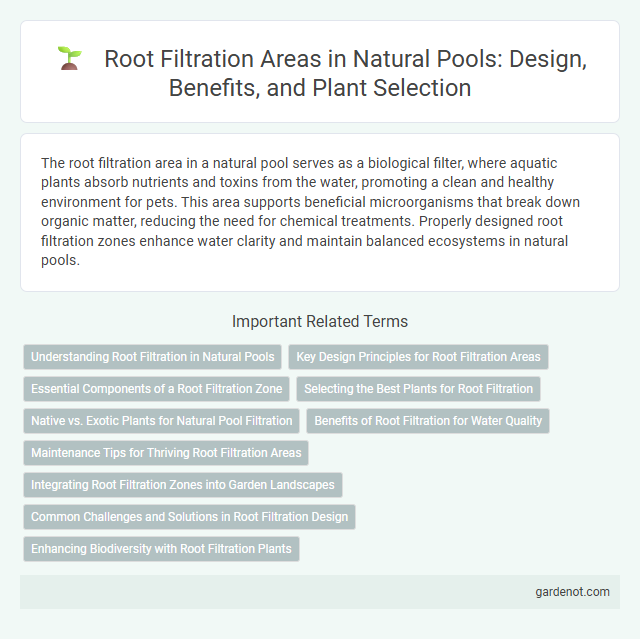The root filtration area in a natural pool serves as a biological filter, where aquatic plants absorb nutrients and toxins from the water, promoting a clean and healthy environment for pets. This area supports beneficial microorganisms that break down organic matter, reducing the need for chemical treatments. Properly designed root filtration zones enhance water clarity and maintain balanced ecosystems in natural pools.
Understanding Root Filtration in Natural Pools
Root filtration areas in natural pools serve as vital biofilters that cleanse water by harnessing the natural processes of aquatic plants. These plants' roots provide extensive surface areas where beneficial bacteria break down organic matter and convert harmful nutrients like nitrogen and phosphorus into less toxic forms. This ecological balance reduces algae growth, promotes water clarity, and maintains a healthy aquatic environment without chemical treatments.
Key Design Principles for Root Filtration Areas
Root filtration areas optimize natural pool water quality by harnessing specific aquatic plants that absorb and break down contaminants through their root systems. Key design principles include selecting diverse, native plant species with extensive root networks, ensuring sufficient area relative to pool volume for effective biofiltration, and maintaining appropriate water flow rates to maximize contact between roots and pool water. Properly designed root filtration zones enhance nutrient uptake, reduce algae growth, and contribute to a balanced aquatic ecosystem.
Essential Components of a Root Filtration Zone
The root filtration area in a natural pool consists primarily of a substrate layer made up of sand, gravel, and biofilm, which supports beneficial bacteria essential for breaking down organic matter and pollutants. Aquatic plants with extensive root systems, such as cattails and reeds, facilitate the absorption of nutrients and provide oxygenation, enhancing the water's natural purification processes. Proper zoning ensures optimal water flow through the root zone, maximizing contaminant removal and maintaining ecological balance within the natural pool.
Selecting the Best Plants for Root Filtration
Selecting the best plants for root filtration in a natural pool focuses on species with extensive root systems that effectively absorb nutrients and filter contaminants. Common choices include water lilies, cattails, and reeds, which enhance water clarity and support microbial activity essential for natural purification. Incorporating native plants adapted to local conditions improves filtration efficiency and promotes biodiversity within the root filtration area.
Native vs. Exotic Plants for Natural Pool Filtration
The root filtration area in a natural pool plays a crucial role in water purification by utilizing plants to absorb nutrients and filter contaminants. Native plants are preferred for natural pool filtration because they are well-adapted to the local climate, support biodiversity, and provide effective pollutant removal without disrupting the ecosystem. In contrast, exotic plants may offer filtration benefits but can become invasive, outcompete native species, and require additional maintenance to prevent ecological imbalance in the root filtration zone.
Benefits of Root Filtration for Water Quality
Root filtration areas in natural pools significantly improve water quality by utilizing plant roots to absorb and break down contaminants such as nitrates, phosphates, and heavy metals. This biological filtration process supports the growth of beneficial microorganisms that further degrade organic matter, promoting clear, algae-free water. Enhanced oxygenation through root systems also reduces harmful anaerobic conditions, creating a balanced aquatic ecosystem with naturally purified water.
Maintenance Tips for Thriving Root Filtration Areas
Regularly remove debris and dead plant material from the root filtration area to prevent clogging and maintain effective water flow. Monitor water levels and ensure the filtration plants receive adequate sunlight to promote healthy root growth and optimal nutrient absorption. Periodic inspection of root health and timely replacement of plants helps sustain a balanced ecosystem and enhances the natural pool's water clarity.
Integrating Root Filtration Zones into Garden Landscapes
Root filtration zones in natural pools utilize aquatic plants' root systems to efficiently purify water by absorbing nutrients and filtering contaminants. Integrating these zones into garden landscapes enhances biodiversity, supports local wildlife, and creates a visually appealing transition between the pool and surrounding greenery. Proper design considers plant selection, root mat density, and water flow to maximize filtration performance and maintain crystal-clear water.
Common Challenges and Solutions in Root Filtration Design
Root filtration areas in natural pools often face challenges such as clogging due to organic debris accumulation and uneven water flow that reduces filtration efficiency. Designing with layered substrates, including gravel and sand, promotes effective water percolation and microbial activity, enhancing pollutant breakdown. Incorporating diverse aquatic plant species with robust root systems stabilizes the substrate and prevents anaerobic conditions, ensuring sustained water clarity and ecosystem balance.
Enhancing Biodiversity with Root Filtration Plants
Root filtration areas in natural pools utilize specialized plants whose extensive root systems efficiently absorb nutrients and contaminants, promoting water purification. These plants support a diverse ecosystem by providing habitat and food sources for beneficial microorganisms, insects, and amphibians, thereby enhancing overall biodiversity. Selecting native species compatible with local conditions maximizes ecological balance and sustainability within the natural pool environment.
Root filtration area Infographic

 gardenot.com
gardenot.com